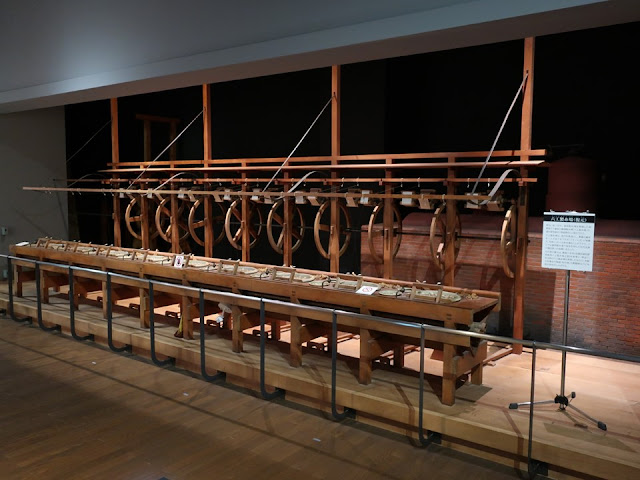The
panels of the ancient period, which depicts people’s lifestyle, are very
understandable. Plus, the full-scale buildings in the past help us to imagine
their lives.
Regarding "Fun of Good Old Japanese", in the Edo period (1603~1868), ordinary people’s lives were
improved; they incorporated puppet shows or plays into their festivals, which
made festivals more enjoyable. Btw, Zenkouji Temple and the silkworm-raising
industry are integral parts of exhibitions of Nagano area.
平安時代までの人々の暮らしを絵にしたパネルがあり、日々の生活をイメージできました。縄文時代から江戸時代までは実物大の家屋(商家を含む)が展示されていて、暮らしむきが分かります。
人びとの楽しみについては、江戸時代になると村人の生活が豊かになり、歌舞伎や人形芝居などを取り入れて村祭りが華やかになったのが印象的でした。そして、養蚕と善光寺は信州の展示には欠かせませんね。
The huge building is a very prefectural museum.
県立にふさわしい大きな建物です。
Jomon period (more than three thousand years ago)、縄文時代
6000年前に八ヶ岳の麓にあった村の再現です。
The panel explains the livelihood of inland very clearly. They cultivated fields near the village and planted trees which gave them nuts. The secondary forest surrounded the planted tree area. It was maintained by villagers in order to supply them foods, firewood and wooden materials. It is called “Sato (village) Yama (mountain)” in Japanese now. It was a real sustainable life which continued until the 19th century. The panel says, “The stable life caused developing the luxurious clayware."
分かりやすいパネルです。「安定した生活の中、華麗な飾りが付いた土器が発達しました」とあります。なるほど。二次林は、今でいう“里山”ですね。そして、与えられた資源だけで生きるサスティナブルな生活です。明治時代まで続いた生活ですね。
Beautiful arrow heads are displayed together with luxurious clayware. Were they tools or accessories? Nagano is a producing center of obsidian.
華麗な土器と共に、美しい石鏃が展示されています。実用品だったのか、装飾品的な価値があったのか、気になります。信州は黒曜石の産地です。
Small and cute clay dolls were excavated in Komoro city.
小諸市で発掘された小さな土偶
Most of family used to sit around a fireplace until the early 20th century. People crushed or grinded nuts, then rinsed them in water in order to remove bitter compounds. Tochi (Aesculus turbinate) nuts contain very bitter ones, so ash lye was added to remove them. It was a primitive food processing.
コナラやミズナラのドングリは、割ったり粉にしたりした後、水にさらして渋みを抜きました。渋みが強いトチは、さらに灰汁を加えて渋みを抜きました。食品加工の始まりです。炉を囲む家族団らんは、20世紀まで続きます。
Yayoi period (around two thousand years ago)、弥生時代
Kohun period (from 4th to 7th century)、古墳時代
Nagano was a horse breeding center because of abundant field. Not only people supplied horses to Yamato Dynasty in Nara prefecture, but also powerful people wore armors and led the cavalry.
信州には広大な原野があり、当時から馬の産地でした。大和政権に駿馬を供給するだけでなく、有力者達は甲冑に身を包み、大和政権を支える騎馬軍団を率いました。
Ancient period (from 8th to 12th century)、古代
Under Yamato Dynasty, Nagano was named “Shinano” province which had ten counties, Provincial capital, provincial temple and highways were designated.
7世紀末に始まった律令制の下では、信州(信濃国)には10の郡がありました。駅家(えきや)を含む街道や国府・国分寺が定められました。国府は、平安時代に小県郡(上田付近)から筑摩郡(松本付近)に移ったと考えられています。
In the Heian period (794-1185), lords (private land owners) and wealthy farmers emerged. The panel of the lord’s residence near Matsumoto shows their lives; some are drinking on the floor and others are doing on the ground in the party.
平安時代になると領主や富裕な農民が現れました。松本平の吉田川西遺跡のパネルには、領主の館と思われる場所での宴会の絵もあります。地べたで飲む人と、屋内で飲む人がいて、リアルです。
Medieval period (from 12th to 16th century)、中世
The approach to Zenkouji temple in the Kamakura period (1185-1333) was rebuilt. It is written, “The principal image (Amida Triad Sharing One Halo) of Zenkouji is thankful, which relieves people at the real and the next world. It is known all over Japan. It is decorated gorgeously by the mandala (Buddhist visual schema of the enlightened mind), Buddhist pictures and altar ornaments. Worshippers are moved while seeing them and deepen their religious faiths.”
鎌倉時代の善光寺門前。「善光寺の本尊は、この世でもあの世でも人びとを救うありがたい仏として、全国に知られた。仏たちの悟りの世界を描いた曼荼羅や、仏画・仏具をきらびやかに飾りたてたようすを目にして、人びとは感激し、信仰を深めた」と書かれています。
The market opened every three times a month. Not only rice but also salmon which was caught at remote beach were sold.
月に三回の市が立つ日は、遠く離れた海であがった鮭や米を売っていたそうです。
Local samurai warriors defeated shugo-daimyo (provincial military governor). The samurai's flag is made of precious silk fabric. However, they were defeated by war lords of the other provinces who were Takeda and Uesugi.
室町時代、信州の武士達は守護を打ち破った(大塔合戦)のですが、武田氏・上杉氏に敗れ、その家臣となって川中島合戦に動員されました。そして、江戸時代に入っていきます。「大文字の旗」は、貴重な絹地で「大」は墨染めです。
Edo period (1603~1868)、江戸時代
Local industry was improved and transportation was also developed. Horses took an important role, because flow of the rivers are too fast in Nagano. There were twenty thousand authorized horses, which carried salt and so on; Nagano doesn’t face sea. Four horses made a group in the south area.
産業が発展し、物流も盛んになりました。信州では川は流れが速いので、水上輸送よりも馬による輸送が発達しました。中馬(ちゅうま)と呼ばれ、二万頭弱の馬が輸送用として公認されました。海がない信州に塩を運ぶ「塩の道」もできました。伊那街道の中馬は四頭立てで、名古屋や豊橋と往復したそうです。
The farmers house above was built around three hundred years ago and moved to the museum. It has straw mat upon the ground and a fire place. There is “Kate-meshi” in the pot, which was a soup of hie (Japanese barnyard millet), daikon (Japanese white radish) and leaves of daikon. It was meager, although many people ate it back then. Mochi cakes and fishes are baked there. The life of the ordinary people is shown precisely.
300年ほど前に立てられた農家が展示室内に移築されています。居間は、地べたに分厚いござを敷いた部屋で、囲炉裏がありました。鍋には「かて飯」(ひえ、大根、大根の葉を入れて雑炊風に煮た江戸時代の主食)が入っていて、五徳の上には焼き餅がのっています。住民を設定して、生活が細かく再現されています。
The economic growth enhanced education and entertainment. The most popular entertainment was a performance during a festival, such as a puppet show, Kabuki play and Sumo wrestling tournament. In Inatani (southern Nagano), “Kuroda ningyo (dolls)” is performed even until now (above). It came from Osaka or Awaji-shim (western Japan).
経済の発展と共に、教育や娯楽も盛んになりました。娯楽のチャンピオンは、祭りの日の人形芝居や歌舞伎、相撲で、伊那谷には淡路島や大阪から人形芝居が伝えられ、「黒田人形」として今も受けつがれています。
There were riots in the 19th century. Farmers attacked rich merchants or farmers. There outfit is displayed. The straw coat transformed a farmer to the powerful being. It is said "the largest number of riots occurred in Nagano." It was more than 200.
江戸後期には、豪農商を襲う世直し騒動が多発しました。一揆の装束が展示されています。珍しいです。日常からの変身のために簑を着たそうです。簑は、夜叉や変身の呪具と考えられていました。信州の一揆は200件が知られ、全国最多といわれています。
The kingdom of sericulture、蚕糸王国長野県
In the Meiji period (1868-1912), sericulture prospered, which was a core industry of Nagano.
明治になり、信州は、長野県になりました。養蚕が基幹産業でした。
Handmade silk (right) is much thinner than machine-made silk (left).
機械で作った生糸(左)と人手で作った生糸(座繰り生糸)。細やかさが違います。
Lifestyle of female employees: They worked fourteen hours a day. They stayed in a dormitory and meals were served. The models of meals (breakfast, lunch and supper) are exhibited; meals consist of a rice, a soup and a dish. A dish of the breakfast is a piece of ume-boshi (pickled plum).
工女さんは、14時間労働でした。朝昼晩の食事も展示されています。一汁一菜、朝の一菜は梅干しでした。
The chronological table in the entrance summarizes exhibits very concisely.
展示室入り口の年表が、内容をコンパクトに示していました。
Nagano Prefectural Museum of History is in Shinano historical park. There are Morishougunduka Tumulus and its museum in the same site.
歴史館は、国史跡「森将軍塚古墳」がある「科野(しなの)の里歴史公園」にあります。古墳の発掘物を紹介する「千曲市森将軍塚古墳館」も敷地内にあります。
Visited
in July, 2021
Official
website: https://www.npmh.net/ (in Japanese), accessed in February,
2022
Previous
post (Preserved resting facility in the neighboring
prefecture): Goryo Chaya-honjin、五料の茶屋本陣
Next post (Museum in Nagano city): Nagano City Museum、長野市立博物館

























Comments
Post a Comment